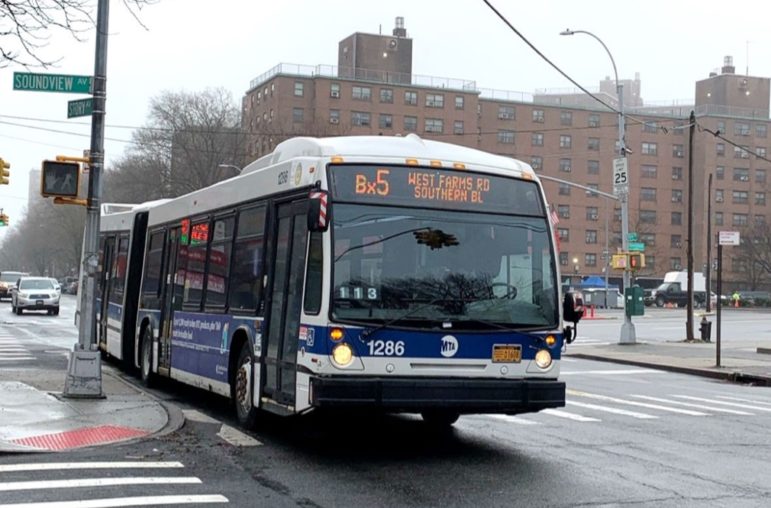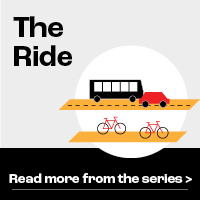Advocates say they would like to see the timely completion of other major projects in the borough before Mayor de Blasio leaves office, including adding bus lanes on Gun Hill Road and University Avenue, and curbing the number of cars and trucks often blocking the bus lanes on Fordham Road.

NYC DOT
The Bx5 runs along Story Avenue and serves some 14,000-plus riders a day.The Bronx doesn’t have any crosstown subway routes, so tens of thousands of residents rely on buses, which aren’t always up to the task. In many parts of the borough, buses go no more than a few miles per hour, pedestrian crossings are too far apart and double-parked cars make it difficult for buses to maneuver through traffic or even pull over at designated stops.
Transit advocacy groups are pushing Mayor Bill de Blasio and the city Department of Transportation to follow through on their Better Buses improvements in the Bronx before the mayor leaves office at the end of the year.
Some of those improvements are imminent: DOT says it will begin implementing bus lanes on Story Avenue this month to speed up service for the Bx5, which carries some 14,000-plus riders each day, a spokesperson for the agency told City Limits.
Advocates say they would like to see the timely completion of other major projects in the borough before de Blasio leaves office, including adding bus lanes on Gun Hill Road and University Avenue, and curbing the number of cars and trucks often blocking the bus lanes on Fordham Road.
“We’re asking the mayor to go back to his convictions, go back to what put him in office—ending the tale of two cities—and say ‘we have one city and it relies on better buses,’” said Danny Pearlstein, a spokesperson for Riders Alliance, which held a rally Wednesday alongside Transportation Alternatives, the Straphangers Campaign, Tri-State Transportation Campaign, TransitCenter and City Council Member Oswald Feliz, who represents the Bronx’s 15th District.
In an email statement, DOT spokesperson Brian Zumhagen said the DOT plans to begin implementing bus lanes on Gun Hill Road next year. Bus lane construction is also currently underway along the southern portion of University Avenue, from Tremont Avenue to the Washington Bridge, and should be completed by the end of the year; lanes further north, from Tremont Avenue to Kingsbridge Road, are “in development and will require further community outreach in the fall,” he said.
“Keeping New Yorkers moving is essential to the city’s recovery, and Mayor de Blasio is prioritizing Bronx projects as part of the Better Buses initiative in 2021,” Zumhagen added.
Bus lanes can reduce traffic issues such as cars blocking bus stops, double parking, weaving and merging. In turn, this increases how fast buses complete their routes. According to a DOT report, bus speeds on Story Avenue currently drop to 5 miles per hour during peak hours.
New York has some of the slowest bus speeds in the country. The average speed is 6.7 mph, according to a 2018 report from the TransitCenter. That’s roughly double the walking speed of an average human and well below the average bus speed of 10 mph in cities like London and Boston, the group says.
“Bus riders have had thousands of hours wasted in slow traffic,” Pearlstein said. “Restoring time to bus riders means more time to earn a living, more time to get an education and help kids get their education and more time to participate in community and the civic life of the Bronx.”
Faster and more reliable buses help create transportation equity, Pearlstein said.
“The Bronx is the place where equity for bus riders is most vivid, most striking, because 95 percent of the bus riders are people of color, and the average income of Bronx bus riders is $20,000 a year,” he said. “Buses are an engine of opportunity in the Bronx like they are nowhere else.”
According to a 2017 report from the City Comptroller’s Office, bus riders generally make less money than subway riders, and are more likely to be immigrants and people of color. Like in many sectors of city policy, the COVID-19 pandemic highlighted disparities in access to reliable transportation.
“Bus ridership was the least elastic; part of that was because bus ridership was free for part of the year so it outpaced subway ridership, but a lot of it was because bus riders are people who have to show for up work in person, whether that’s in a health care setting, a pharmacy, a grocery store or a daycare,” Pearlstein said. “Very large percentages of the bus riders are essential workers, and they have punishing commutes. The bus is really a critical connector for essential work.”
Pearlstein said one of the few silver linings of the pandemic was that bus speeds skyrocketed because less people were on the road.
“Tragically, there was an epidemic of wrecks with some people taking to the roads at 100 mph, but there was also, finally, fast and reliable bus trips,” he said. “At the time, we and the MTA jointly called on the mayor to help cement some of those gains, and we achieved the Better Buses Restart.”
Initiated in June 2020, Better Buses Restart resulted in 16 miles of new bus lanes, the largest one-year effort in city history, according to the MTA.
De Blasio has roughly six months left in officer before a new administration takes over. After that, advocates say they’ll continue to press the next mayor for more bus system improvements.
Democratic mayoral candidate Eric Adams has expressed support for improved bus service, the Bus Rapid Transit network and electric buses. As Brooklyn Borough President, he’s has joined the Riders Alliance during rallies against bus budget cuts in the past
Republican candidate Curtis Sliwa has focused more on subway travel, where he made a name for himself in 1980s as founder of The Guardian Angels, a civic public safety group that would ride the trains in an effort to deter crime and violence. Sliwa remains concerned with subway safety, and would like to see more police officers stationed in terminals.. In May, before the primary elections, he challenged the Democratic hopefuls to ride the subway with him for 24 hours and offered hockey masks to wear in case they feared getting slashed in the face. None of the candidates joined him.
Pearlstein says there is enough time for de Blasio to create more new bus lanes before he leaves office, since they are inexpensive and easy to install.
“All you need is political will,” he said. “The DOT got some pushback on the Story Avenue lanes from some people who like to drive in that area, but they didn’t hear from the 15,000 bus riders.”
He pointed to earlier city projects that successfully improved bus service for riders.
“These are really transformative projects,” he said. “On 149th Street they unsnarled a major commercial corridor. On the E. L. Grant Highway, they pioneered new techniques to really speed buses that travel a long distance and bring people from low-income communities in the South Bronx to jobs in Washington Heights in Manhattan. These are patterns that can be repeated all across the Bronx.”










2 thoughts on “City to Install Story Ave. Bus Lanes This Month, As Advocates Push for Other Bronx Fixes”
Thanks for covering this.
Bus lanes are one of the tools we have to quicken travel time, and they should have priority on the street. The DOT must do what is necessary to prioritize them over private vehicles.
I will add that the SBS Bx6 will also soon travel along Story Avenue so there will be increased frequency and ridership along the route which further justifies bus lanes.
Totally agree with you!